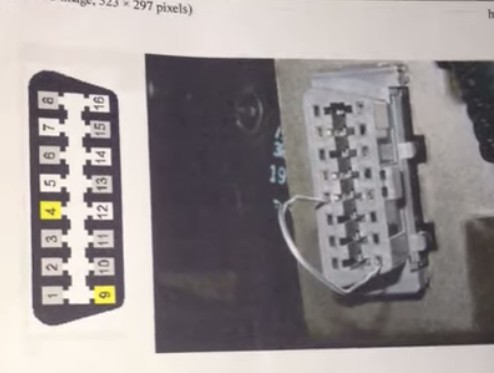Experiencing issues with your 2004 Honda Element’s OBD2 port? Many DIY mechanics and car owners rely on the OBD2 port for diagnostics and troubleshooting. If you find that your OBD2 scanner isn’t powering up or connecting when plugged into your Honda Element, you’re likely facing a frustrating problem. One common, yet easily made mistake, can lead to a non-functional OBD2 port and other electrical issues in your vehicle. This article explores a real-world scenario and offers guidance on how to troubleshoot a “2004 Honda Element Obd2 Port Not Working” situation, especially after a potential short circuit incident.
The Case of the Mistaken Jumper Wire
One Honda Element owner encountered a blinking “D” indicator on their dashboard, signaling a potential transmission issue. Following online forum advice to check for diagnostic trouble codes (DTCs) using a jumper wire in the OBD2 port, they unfortunately made a critical error. Instead of correctly bridging pins 4 and 9 to read the transmission codes, they mistakenly jumpered pins 5 and 16.
 Correct OBD2 port pin configuration for Honda Element diagnostic code retrieval
Correct OBD2 port pin configuration for Honda Element diagnostic code retrieval
According to standard OBD2 pinout diagrams, pin 16 provides +12V battery power, while pin 5 is a signal ground. Inadvertently connecting these two pins creates a short circuit. While the owner successfully read their transmission code after correcting the jumper, they soon discovered several electrical accessories were no longer functioning. This highlights a crucial lesson: incorrect manipulation of the OBD2 port can lead to significant electrical problems in your 2004 Honda Element.
Symptoms of a Non-Functioning OBD2 Port and Related Electrical Issues
After the jumper wire mishap, the Honda Element exhibited a range of electrical malfunctions. Here’s a breakdown of what was working and what wasn’t:
Working:
- External lights (headlights, turn signals, brake lights)
- Backup lights
- Rear hatch dome light
- 12V accessory socket in the passenger dash
- Power windows
- Power mirrors
Not Working:
- Radio
- Dome light (only works when the key is in the ‘ON’ position)
- Power locks:
- Key ‘ON’: Unlock button works, Lock button does not. Manually pushing down the lock stem locks all doors.
- Key ‘OFF’: Lock buttons do not work, manual lock stem is ineffective on other locks.
- Remote key fob (no functions)
- Cruise control on/off button (no illumination)
- OBD2 port itself (no power at pin 16, scanner does not power on)
These symptoms suggest that the short circuit affected specific circuits within the vehicle’s electrical system, particularly those related to interior accessories and the OBD2 port’s power supply. Notably, the OBD2 port itself was no longer providing power, rendering it unusable for diagnostics.
Troubleshooting a Dead OBD2 Port on a 2004 Honda Element
If you’re facing a “2004 honda element obd2 port not working” situation, especially after a potential electrical incident, here’s a systematic troubleshooting approach:
-
Check Fuses: The first and most crucial step is to inspect your Honda Element’s fuse boxes. Consult your owner’s manual to locate the fuse box diagrams. Look for fuses related to:
- OBD2 port / Data Link Connector (DLC) – often labeled as “OBD,” “DLC,” or “Diagnostic.”
- Radio and interior lights – since these are also affected.
- Power door locks and cruise control – as these are also non-functional in this case.
Visually inspect each fuse for a broken filament. Even better, use a fuse tester to confirm continuity. Replace any blown fuses with the correct amperage rating.
-
Wiring Inspection: If the fuses are intact, the next step is to examine the wiring around the OBD2 port and the affected accessories. Look for:
- Damaged or melted wires near the OBD2 port.
- Loose or corroded connectors.
- Signs of wire chafing or damage along the wiring harness.
-
Grounding Issues: A short circuit can sometimes affect ground connections. Check the ground points for the affected circuits to ensure they are clean and securely fastened to the vehicle’s chassis.
-
Relay Check: Some circuits utilize relays. While less likely in this scenario, it’s worth checking the relays associated with the radio, interior lights, and power door locks to ensure they are functioning correctly. You can usually swap relays with identical ones from non-essential systems to test.
-
Professional Diagnosis: If you’ve checked fuses and wiring and the OBD2 port is still not working, and the other electrical issues persist, it’s advisable to seek professional help from a qualified mechanic. They will have access to wiring diagrams and specialized diagnostic tools to pinpoint the exact cause of the problem, which could potentially be a more serious issue like a faulty ECU or body control module.
While a simple jumper wire mistake can lead to a “2004 honda element obd2 port not working” scenario and related electrical problems, systematic troubleshooting, starting with fuse inspection, can often resolve the issue. However, when dealing with vehicle electrical systems, caution and a methodical approach are always recommended. If you’re uncomfortable working with electrical systems, professional diagnosis is the safest course of action.